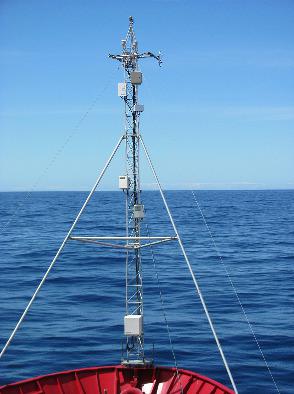当前位置:
X-MOL 学术
›
Q. J. R. Meteorol. Soc.
›
论文详情
Our official English website, www.x-mol.net, welcomes your
feedback! (Note: you will need to create a separate account there.)
Observations of air–sea heat fluxes in the southwestern Atlantic under high‐frequency ocean and atmospheric perturbations
Quarterly Journal of the Royal Meteorological Society ( IF 3.0 ) Pub Date : 2020-09-09 , DOI: 10.1002/qj.3905 M. F. Santini 1 , R. B. Souza 2 , L. P. Pezzi 1 , S. Swart 3, 4
Quarterly Journal of the Royal Meteorological Society ( IF 3.0 ) Pub Date : 2020-09-09 , DOI: 10.1002/qj.3905 M. F. Santini 1 , R. B. Souza 2 , L. P. Pezzi 1 , S. Swart 3, 4
Affiliation

|
Turbulent air–sea heat fluxes were computed from in situ high‐frequency micrometeorological data during two research cruises performed in the southwestern Atlantic Ocean (SWAO) occurring in June 2012 and October 2014. Two different and dynamical areas were covered by the cruises: the Brazil‐Malvinas Confluence (BMC) and the Southern Brazilian Continental Shelf (SBCS). The eddy covariance (EC) method was used to estimate the air–sea sensible‐ and latent‐heat fluxes. This article compares these novel high‐frequency estimates of heat fluxes with bulk parametrizations made at the same location and time from independent measurements taken on board the ships. When comparing the EC and bulk‐estimated time series of sensible‐heat fluxes, we found a good agreement both in their magnitude and variability, with small bias (generally <20 W·m−2) between the datasets from the two study areas in the SWAO. However, the EC and bulk latent‐heat flux comparisons show large biases ranging from 75 W·m−2 to 100 W·m−2 in the SBCS and BMC, respectively. These biases were always associated with short‐term, high‐frequency environmental perturbations occurring either in the atmosphere or in the ocean with the majority related to strong wind burst events and large air–sea temperature gradients. The short period changes in atmospheric conditions were mostly related to the passage of transient synoptic systems over the two study areas. The large air–sea temperature gradients were mostly linked to the surface characteristics of the BMC and SBCS regions, where sharp oceanographic fronts are located. Our results are able to contribute to improving weather and climate simulations of the mid‐ to high latitudes of South America, a region largely influenced by the sea‐surface temperature patterns of the SWAO in combination with the frequent propagation of transient atmospheric systems.
中文翻译:

高频海洋和大气扰动下西南大西洋海气热通量的观测
从原位计算出湍流的空气-海洋热通量在2012年6月和2014年10月在西南大西洋(SWAO)进行的两次研究航行期间,获得了高频微气象数据。这些航行涵盖了两个不同的动态区域:巴西-马尔维纳斯汇合处(BMC)和巴西南部大陆货架(SBCS)。涡旋协方差(EC)方法用于估算海气的感热通量和潜热通量。本文将这些新颖的高频热通量估计值与在船上进行的独立测量在相同位置和时间进行的整体参数化进行了比较。在比较EC和显热通量的估计时间序列时,我们发现它们的大小和变异性都具有良好的一致性,并且偏差很小(通常<20 W·m -2)在SWAO中两个研究区域的数据集之间。但是,EC和整体潜热通量的比较显示出大的偏差,范围从75 W·m -2到100 W·m -2分别位于SBCS和BMC中。这些偏差总是与在大气或海洋中发生的短期高频环境扰动有关,大多数与强风爆发事件和较大的海-海温度梯度有关。大气条件的短期变化主要与两个研究区域内瞬变天气系统的通过有关。较大的海气温度梯度主要与BMC和SBCS地区的表面特征有关,这些地区位于锋利的海洋学前沿。我们的结果有助于改善南美中高纬度地区的天气和气候模拟,
更新日期:2020-09-09
中文翻译:

高频海洋和大气扰动下西南大西洋海气热通量的观测
从原位计算出湍流的空气-海洋热通量在2012年6月和2014年10月在西南大西洋(SWAO)进行的两次研究航行期间,获得了高频微气象数据。这些航行涵盖了两个不同的动态区域:巴西-马尔维纳斯汇合处(BMC)和巴西南部大陆货架(SBCS)。涡旋协方差(EC)方法用于估算海气的感热通量和潜热通量。本文将这些新颖的高频热通量估计值与在船上进行的独立测量在相同位置和时间进行的整体参数化进行了比较。在比较EC和显热通量的估计时间序列时,我们发现它们的大小和变异性都具有良好的一致性,并且偏差很小(通常<20 W·m -2)在SWAO中两个研究区域的数据集之间。但是,EC和整体潜热通量的比较显示出大的偏差,范围从75 W·m -2到100 W·m -2分别位于SBCS和BMC中。这些偏差总是与在大气或海洋中发生的短期高频环境扰动有关,大多数与强风爆发事件和较大的海-海温度梯度有关。大气条件的短期变化主要与两个研究区域内瞬变天气系统的通过有关。较大的海气温度梯度主要与BMC和SBCS地区的表面特征有关,这些地区位于锋利的海洋学前沿。我们的结果有助于改善南美中高纬度地区的天气和气候模拟,











































 京公网安备 11010802027423号
京公网安备 11010802027423号